
No holiday table would be complete without beautiful festive cranberries. Whether you like your cranberry sauce fresh or from a can, there’s just something about that deep red color and distinctive tartness that speaks to cherished tradition and good times.
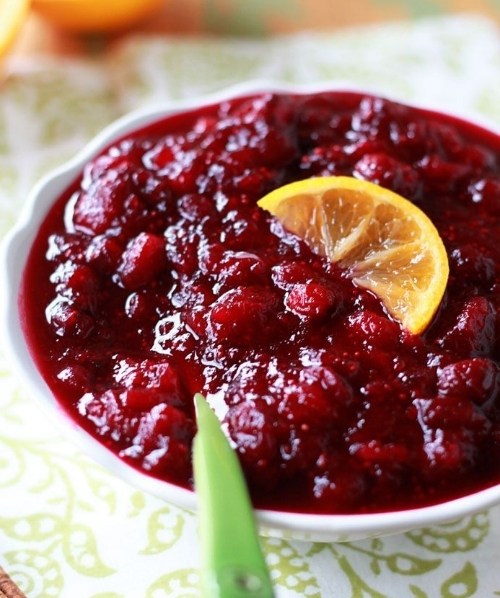
Alongside the magnificent gobbler and tricked-out starchy sides, cranberry sauce is like the pampered guest who knows it was invited to dinner just as much for its prettiness as its flavor. Not snobby in the least, cranberries enjoy being appreciated for their good looks.
In the past I’ve made lovely cranberry wreaths for the front door, strung garlands of it with popcorn to adorn our Christmas tree, baked them into muffins and breads, and made a delicious relish with grated orange rind. Often, if I’m asked to bring a side dish on Thanksgiving, I’ll make a cooked cranberry gelatin mold — one part retro, two parts jiggle. 🙂
I would venture to say that what most of us know about picking cranberries is limited to those entertaining Ocean Spray commercials. We know a lot of water is involved, along with plaid flannel shirts and cool waders. It looks like such fun to wade through that ocean of red — nature’s jewels!
Now there’s a brand new picture book called Time for Cranberries (Roaring Brook Press, 2015) by Lisl H. Detlefsen and Jed Henry, and all I can say is, “It’s about time!”
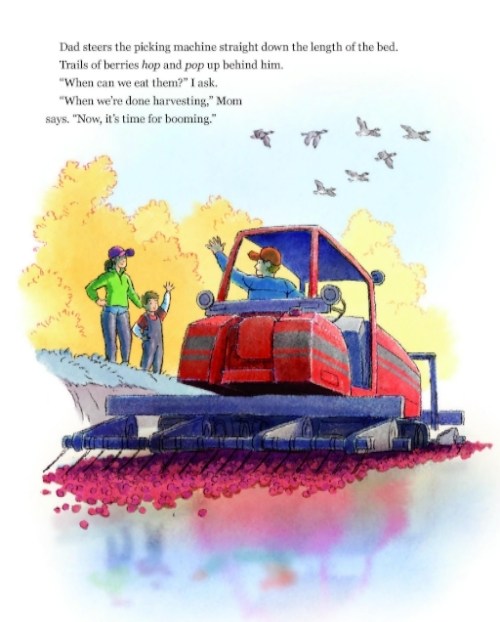
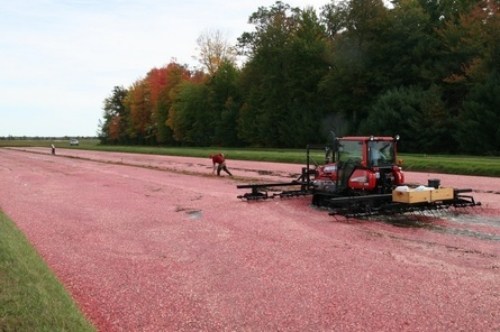
This charming story is told from young Sam’s point of view. He’s finally old enough to help his parents harvest the cranberries on their marsh. The beds have already been flooded for picking, so Sam’s father drives the big picking machine down the length of the bed to loosen all the berries from their vines. Next comes booming — using long foam-filled floating spools to collect the berries so they can be corralled into a big bunch called a pot. After the “spinning paddles push the cranberries to the suction pump and into the cleaner,” the good berries are piled into the delivery truck to be taken to the receiving station.
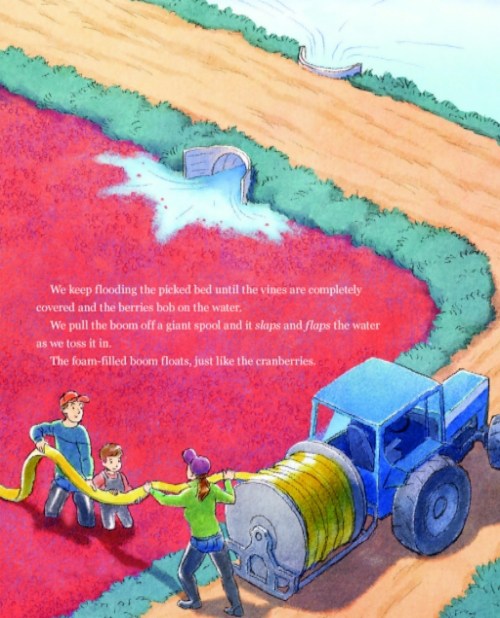

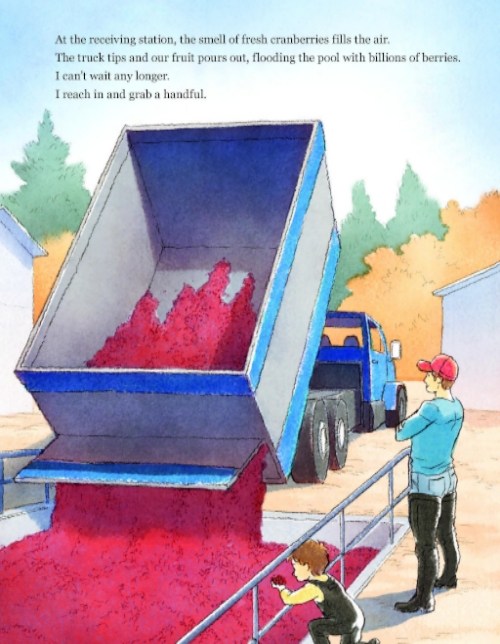
Lisl has done a wonderful job of describing the entire process in her engaging narrative. We can feel Sam’s enthusiasm and how much he loves helping out, even when he falls into the bed and must change into dry clothes. As Sam and his parents “shlip” and “shlerp” in the mud, huff and puff as they lasso the cranberries, and splish and splash each other, we can’t help but wish we could join the fun. We can also relate to Sam’s eagerness to eat the berries, our lips puckering right along with his as he finally gets a taste. Best of all, homemade cranberry pies for Thanksgiving!
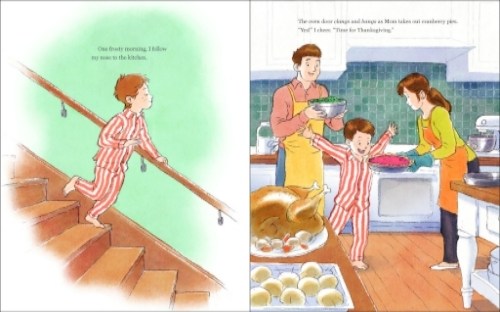
Jed Henry’s detailed, realistic drawings of harvesting equipment and the step-by-step process are set against a lustrous backdrop of vivid autumn colors. He’s also captured the warmth of family and the joy of working together, making the story feel very personal and accessible. I also liked seeing Sam’s grandparents sitting on the porch and wildlife like deer, foxes, and geese roaming about the farm.

Time for Cranberries, Lisl’s debut picture book, is a welcome addition to the stockpile of pumpkin and apple Fall books, especially since it was written by someone who knows all about cranberries from the inside out. Lisl and her family live on Whittlesey cranberry marsh in Wisconsin, where cranberries have been cultivated for five generations.
Her book, which includes two recipes, an Author’s Note and a Glossary, heightened my appreciation for one of North America’s few native fruits, and made me even more thankful for the small farmers who help bring good quality food to our tables.
So, what’s it really like to live on a cranberry bog? Is there anyone in her family who doesn’t like to eat cranberries? What were some of the challenges of writing a factual story that would appeal to young children? I thank Lisl for visiting today to tell us more and share some cranberry pie. 🙂
* * *
🍂 A CRANBERRY CHAT WITH LISL H. DETLEFSEN 🍂
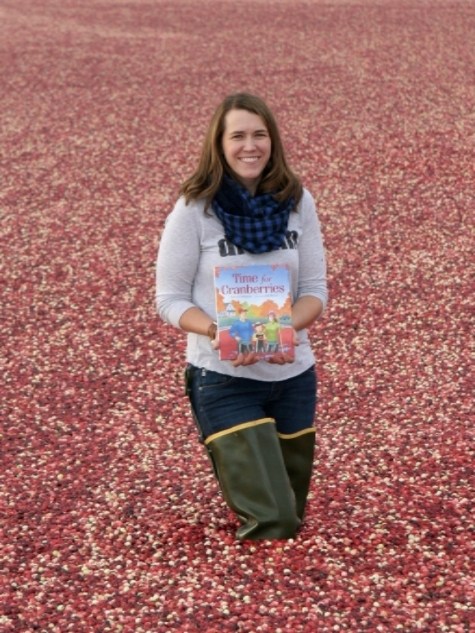
How does it feel to have your first picture book out in the world? What’s been the best part of this experience so far?
Having my first book out in the world is so exciting! It’s also a little bit nerve-wracking, of course, to send your “book baby” out into the world and get the reactions of everyone from friends to reviewers. The best part of the experience has been seeing how the cranberry community has embraced it. I’ve received such positive feedback from parents and kids who live on marshes and are excited to see their own lives reflected in a book. And I know cranberry growers who are showing the book to friends and family members who live far away and have never totally understood before what it is we do at harvest. I’m very honored to help tell the story of a group of people who are so close to my heart.


Please share a few things about growing or harvesting cranberries that might surprise the average person. Do the beds remain flooded throughout the year? What’s the marsh like in winter, spring and summer?
It’s a common misconception that cranberries grow in water– the cranberry vines need oxygen like other plants and are only in the water for a short time during harvest. They actually don’t need to be in water for harvest, either, but using this “wet harvest” method allows us to take advantage of the cranberry’s ability to float. Inside each cranberry are four pockets of air that cause them to bounce and float. Once picked, it is easier and quicker to remove the floating berries from the cranberry beds and get them to the receiving station, as described in my book.
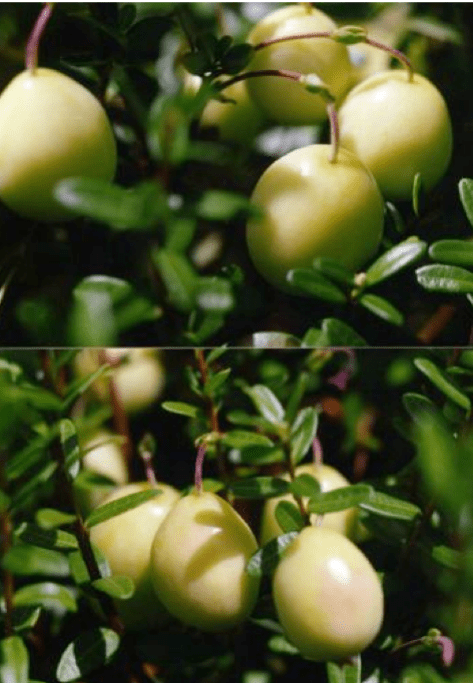
Cranberries are a perennial plant and the vines are dormant during the winter. They “wake up” during the spring thaw and blossom in late June. Their beautiful blossom looks like the head and neck of a sandhill crane, which is how the fruit got its name, originally CRANE-berry. The berries then grow all summer, from a tiny pinhead to a larger, greenish berry. Once the berry reddens, it’s time for harvest!

Which part of Fall harvesting do you like most and why?
While not technically part of the harvest process, I love the COLOR! I have a background in art, which perhaps makes me more inclined to notice beauty in my everyday surroundings. The first time I saw harvest, I felt like Dorothy stepping into Oz. The color is so vibrant, featuring the primary colors of the brilliant red berries bobbing on the water, the vibrant yellow leaves fluttering down from the trees, and the blue of the water and sky. Even the tire tracks from different types of equipment form interesting patterns in the mud on the dams and roads. Every year, the incredible color astounds and delights me.
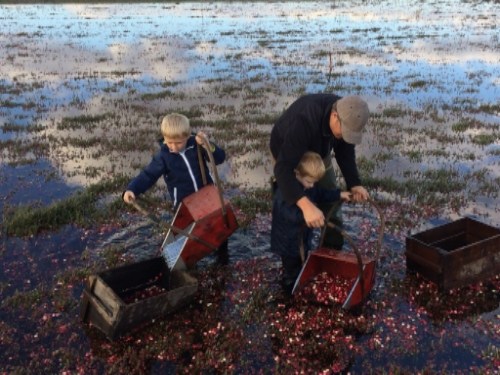
What was the most challenging part of writing this story? Did you do many revisions?
Oh my goodness, SO many revisions! I have at least 28 different drafts of cranberry stories, saved under eight different titles on my computer–and those are just the drafts I saved! This book began as a strictly non-fiction photo essay told in third person past tense. The published form is still process-based, but it follows a fictional family through the harvest process and is told in present tense from the main character’s perspective. Ultimately, the biggest challenge was keeping the process of harvest clear and accurate while balancing it with the emotional journey of Sam, the main character. Luckily, I had the help of my amazing editor to guide me through that!

How long did this project take from initial idea to published book? How did you find your agent?
No beginning writer wants to hear this, but it took ten years from the very first draft to the sale of the finished project. Of course, in that time I wrote many other stories, did other work like freelance writing, and had two babies, too. While it was a long journey, it was definitely worth it to have the right version of the book find the right publishing home.
I found my agent several months after the sale of Time for Cranberries. I’ve been a member of SCBWI for a long time, and attended SCBWI-Wisconsin’s Agent Day workshop in the spring of 2014. Later that year, I signed with one of the four agents who presented at that workshop, and I couldn’t be happier. Working with her has made it clear to me how important it is not just to have an agent, but also to have the RIGHT agent for you. My agent is editorial, thoughtful and very organized—all very important qualities to me. I think it can be hard to get a feel for agents through research alone, so attending Agent Day was a great opportunity to meet four agents at once and hear them all speak. And of course, finding my agent in this way is one of the many reasons why I am a huge advocate of being a member of SCBWI!

Any tips for turning real life experiences into fiction?
I just gave a presentation on this very topic at an SCBWI-Wisconsin event! Thoughtfully examine when you need to strictly follow how the experience truly was and when you’re allowing “how it really happened” to get in your way. (This advice is strictly for writing FICTION, of course!) True details that help make your story feel authentic and accurate are important, but sometimes your real life experience lacks a satisfying ending or has too many unnecessary characters. Whether your personal experience creates the initial spark or is responsible for the bulk of your story, it shouldn’t keep you from doing necessary research and has to have universal appeal.
Did you provide reference photos for the illustrator? Which is your favorite spread and why?
I did provide photos and video references for illustrator Jed Henry since he doesn’t live in an area where cranberries grow. He did such beautiful work on the book that in my opinion he’s earned the title of honorary cranberry grower!
My favorite spread is the last one of harvest, which is an aerial view of the marsh. You can see all the steps of harvest at once—from picking to the fruit going into a delivery truck—along with the beauty of fall. Jed even included the appropriate wildlife, too, which I adore!


What do your husband and sons think of the book? How do your boys participate in the harvest?
I am extremely lucky–my husband has been supportive of my writing dream every step of the way. He has more than earned the dedication in the book! And there is no greater gift than one of my boys asking me to read the book to them again.
My boys love to put on their waders and walk out in the flooded beds during harvest. Since he’s not in school fulltime yet, my youngest is especially fond of riding in the back of his Dad’s pickup truck, watching the harvest equipment and eating fresh, raw cranberries by the handful (like Sam in the book!)

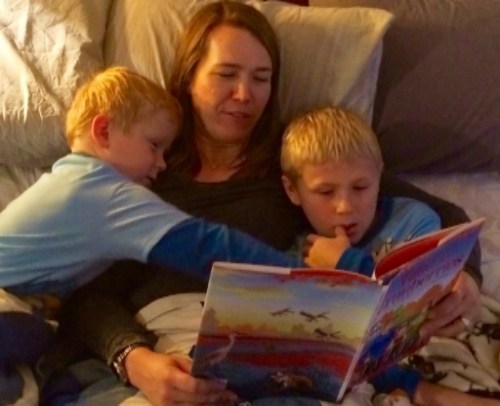
Does everyone in your family like to eat cranberries? Besides making cranberry sauce and pie, have you found other creative ways to use cranberries in your cooking or baking?
We’re all pretty die-hard cranberry lovers, but we vary in our recipe preferences. Cranberries are so versatile, in baking or cooking. My family loves smoothies, so I often toss a handful into the blender with other berries, ice, coconut milk and yogurt for a quick breakfast. Baked goods made with cranberries, like scones or muffins, are hard to beat, but my mom makes a delicious cranberry-glazed pulled pork, too. Right now we’re on a cranberry bread kick at our house. Sometimes I even use it to make cranberry French toast.

What’s next for you?
I’m very excited about my second picture book, “If You Had a Jetpack,” due out sometime in 2017 from Random House/Knopf.
In terms of works-in-progress, I always like to juggle several projects at once. My literary true love is picture books, so I always have a number of those in various stages, from first draft to being out on submission. My other big project right now is revising a novel that’s close to my heart.
*

AUNT KRISTEN’S CRANBERRY PIE
- 3 cups of cranberries, cut in half
- 1/2 cup of brown sugar
- 1 pie crust for a 10-inch pie pan
- 2 eggs
- 1 cup of white sugar
- 1 cup of flour
- 1/2 cup of melted butter
- Aluminum foil
Mix the cranberries and brown sugar together and spread evenly in the bottom of the unbaked pie crust. Using an electric mixer, beat the eggs well. Add the white sugar and beat until well combined. Mix in the flour and melted butter, adding a little of each at a time. Spread the batter (it will be thick) over the cranberry mixture in the pie crust. Cover the crust edges with aluminum foil and bake at 400 degrees for 15 minutes. Then place the foil over the whole pie, turn the oven down to 350 degrees, and bake for 45-50 minutes. Remove all of the aluminum foil and bake uncovered for the last 5 minutes, or until the batter is set and the top is golden brown. Serve plain or with a scoop of vanilla ice cream.

*

TIME FOR CRANBERRIES
written by Lisl H. Detlefsen
illustrated by Jed Henry
published by Roaring Brook Press, September 2015
Picture Book for ages 3-7, 32 pp.
*Includes Author’s Note, Glossary and 2 Recipes
**A Junior Library Guild Selection
♥ Visit Lisl’s website for a comparative view of her family’s marsh and Jed Henry’s illustrations.
*
![]() This post is being linked to Beth Fish Read’s Weekend Cooking, where all are invited to share their food-related posts. Put on your best bibs and gobbles, and come join the fun!
This post is being linked to Beth Fish Read’s Weekend Cooking, where all are invited to share their food-related posts. Put on your best bibs and gobbles, and come join the fun!
——————————————————
*Interior spreads from Time for Cranberries posted by permission of the publisher, text copyright © 2015 Lisl H. Detlefsen, illustrations © 2015 Jed Henry, published by Roaring Brook Press/Macmillan. All rights reserved.
Copyright © 2015 Jama Rattigan of Jama’s Alphabet Soup. All rights reserved.

Such a beautiful post, 🙂 Thank you, love, nia
LikeLike
Glad you enjoyed it! Thanks for visiting, Nia!
LikeLiked by 1 person
I **love** cranberries. And I too thought cranberries grew in the water, so I’m happy to learn the real story. What a great book on so many levels: the story, the information, the illustrations. Great post (as always)
LikeLike
It’s a very common misconception that cranberries grow in the water — the Ocean Spray commercials never show the plants in any other season than at harvest. I love this book and learned a lot!
LikeLike
Great post. What an informative story! We have seen these crimson fields at harvest time while driving through Wisconsin and they are stunning.
LikeLike
Lucky you! I’d love to see them sometime!
LikeLike
Fascinating! I would love to read this book. The illustrations look great, too. Your cranberry gelatin mold sounds fun, Jama.
LikeLike
I hope you get to see this book soon, T!
LikeLike
I love cranberries, and love that there is a picture book about them. What a treat! I actually visited a cranberry farm with my students years ago on a trip to the Boston area. We watched the harvest and were given berries which we cooked and used in pancakes. We were staying at a youth hostel in Boston. I do love them in all things, so thanks for the new recipe, but my real love is a cranberry relish recipe which I make for Thanksgiving, grinding cranberries, oranges and pecans all together, add sugar, and yum! Happy Thanksgiving, Jama, and thanks to Lisl for a wonderful book!
LikeLike
Cool that you got to watch a cranberry harvest, Linda! For some reason, I always thought most of the cranberries were grown in New England — but Wisconsin is king! Your cranberry relish sounds so yummy — cranberries go so well with oranges. Have a great Thanksgiving!
LikeLike
As on of those weirdies who eats cranberries… raw… this is fascinating to me. I just adore all things cranberry as well. What a treat! Also, I laughed – indeed, we’re all about the Ocean Spray commercials here, too — waders and people standing in cranberries was all I knew. They never show the flowers, and they should! They’re gorgeous. Thanks for all the great pics.
LikeLike
I also didn’t realize Ocean Spray was a farmers coop! I like raw cranberries in relish. 🙂
LikeLike
What a charming book! I can’t wait to read it. Thanks for the wonderful interview and for telling me about the book. And it is always such eye candy to read your blog!
LikeLike
It’s really charming, Rosi — hope you see it soon. Love how Lisl conveyed so much interesting info in an engaging story told from a kid’s POV. There just aren’t that many PBs about cranberries so this title is extra special. 🙂
LikeLike
Another cranberry lover here.Thanks for the recipe too. I needed something new for dessert.
LikeLike
The cranberry pie looks delicious. Hope you try it and report back. 🙂
LikeLike
Oh, my! Would you believe as I’m reading this, at midnight, one reason I’m still up is I couldn’t imagine making our Thanksgiving journey tomorrow without cranberry sauce! So it’s bubbling in the kitchen as I write this, and I’ll just pack it in a cooler or something. I learned so much in this post – and the gorgeous book looks/sounds cranberry-delicious. :0)
Thanks for sharing, and Congrats to Lisl!
LikeLike
Cranberry sauce is a MUST! Enjoy your feast tomorrow, Robyn!!
LikeLike
I just put this on hold at my library. Every time I see that commercial on TV with the two men standing in the cranberries, I wonder about how cranberries are harvested. This will be perfect! Can’t wait to read it.
LikeLike
I’m sure you’ll enjoy this book, Penny. I always wondered the same thing whenever I saw those Ocean Spray commercials. Our cranberry sauce and muffins were extra special yesterday because of this book :).
LikeLike
A fabulous review and interview Jama. All I didn’t know about cranberries. Being so far from cranberry country, I usually mix in other fruit with my Thanksgiving sauce. This year it was cranberry starfruit sauce.
LikeLike
Starfruit! Haven’t seen any since decades ago in my childhood. Interesting combo!
LikeLike
I can only get dried cranberries here – would love to get my hands on some fresh ones. Cheers from Carole’s Chatter!
LikeLike
Fresh ones are great :)!
LikeLike
I am going to buy this for my grandchildren! Thank you. It looks wonderful. I love cranberries and use them a lot. (even cranberry juice in my cosmo haha) There’s another children’s book you might like called Cranberry Thanksgiving by Wende and Harry Devlin. I am very surprised that Carole cannot buy fresh cranberries. I thought Ocean Spray shipped them all over the country. I am lucky to buy mine at my local coop store fresh from Vermont – not even bagged, just in a big box and I scoop them out. One of my favorite foods. Thanks again.
LikeLike
I’ll look for Cranberry Thanksgiving, Nan. Thanks!
I think Carole lives in New Zealand :).
LikeLike
I love everything about this! Thank you so much for sharing 🙂
LikeLike
Thanks for reading!!
LikeLike
What a beautiful post. To me it’s a celebration of the wonderful cranberry. I am finding this book to share with grandchildren.
LikeLike
Cranberries should be celebrated whenever possible. Enjoy sharing this book with your grandkids, Margot!
LikeLike
I don’t live far from Massachusetts cranberry country, so I did know about flooding the fields for harvesting. In fact, I pass a bog every day on my way to work! What I’ve heard from a local grower I know is that the prices of fresh cranberries have dropped so low that it’s hard for small local farmers to make a living growing cranberries, which is sad. It’s great to hear about this picture book, though, and the cranberry pie looks delicious!
LikeLike
Sorry to hear that, Laurie. All the more reason to appreciate and try to support our small farmers whenever possible.
LikeLiked by 1 person
You pick the best authors (and books)!
LikeLiked by 1 person
Thanks, Erik. Glad you enjoyed reading about Lisl’s new book!
LikeLike